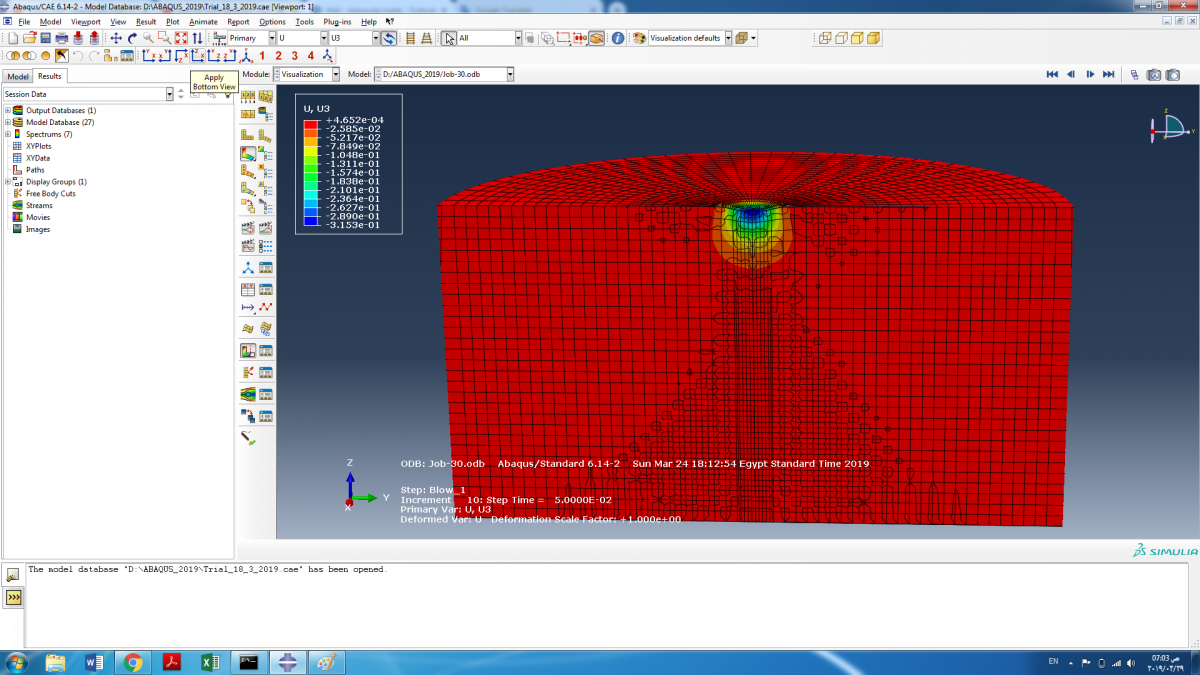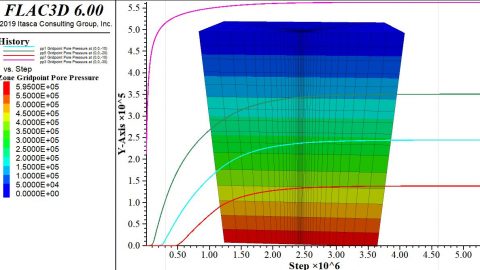Not able to run the subroutine ……..error is coming ……UMAT: illegal (negative) actual void ratio detected
Can anybody help
Hypoplastcity sand model
Related Articles
-
sand liquefaction modelling in Anura3D
 Daniel Brox||Constitutive Modelling|0 |Views 498
Daniel Brox||Constitutive Modelling|0 |Views 498
Beginner level question for this forum – Trying to replace a Mohr-Coulomb model of sand in an Anura3D simulation with a material model which accurately describes sand liquefaction. References I’ve […] -
Dynamic Compaction Simulation by ABAQUS
 shenouda Mekhail||Constitutive Modelling|0 |Views 4,504
shenouda Mekhail||Constitutive Modelling|0 |Views 4,504
Greeting Everyone, I’m a new user of ABAQUS. I’m trying to simulate soil dynamic compaction by Cap model. I simulated the blow by half sinusoidal wave. Although I used Cap […] -
Rate dependent plastic yield in Tochnog Question
 Marlon Hahn||Constitutive Modelling|0 |Views 4,000
Marlon Hahn||Constitutive Modelling|0 |Views 4,000
Hi, I am new to Tochnog and really appreciate the open source modeling chain (gmsh->Tochnog->paraview). So far, I’m only familiar with commercial codes, e.g. Abaqus. I actually deal with metal […] -
PM4Sand and PM4Silt models available
 Katerina Ziotopoulou||Constitutive Modelling|4 |Views 4,697
Katerina Ziotopoulou||Constitutive Modelling|4 |Views 4,697
The constitutive models PM4Sand (Boulanger and Ziotopoulou 2017) and PM4Silt (Boulanger and Ziotopoulou 2018) for plane-strain earthquake engineering applications for sands, and clays and low-plasticity silts respectively are now available […] -
Calibration of the von Wolffersdorff model using Genetic Algorithms
 Francisco Mendez||Constitutive Modelling|3 |Views 4,128
Francisco Mendez||Constitutive Modelling|3 |Views 4,128
I am happy to announce that our pre-print paper, “Calibration of the von Wolffersdorff model using Genetic Algorithms”, is available on researchgate: https://www.researchgate.net/publication/342198062_Calibration_of_the_von_Wolffersdorff_model_using_Genetic_Algorithms. In this article, we propose a novel […] -
need help in Flac3d6
 Ahmed Mahir||Constitutive Modelling|0 |Views 4,120
Ahmed Mahir||Constitutive Modelling|0 |Views 4,120
dear user hello i intend to build a numerical model using flac3d 6 software i build the geometry with extrusion pane and set all values for pile – soil interaction […] -
abaqus version
 sobhan abedinnejad||Constitutive Modelling|3 |Views 3,998
sobhan abedinnejad||Constitutive Modelling|3 |Views 3,998
hi every one i’m using abaqus 2017 and i want to implement Hypo-sand to my Biaxial model (2D) and before all, i linked abaqus and fortran successfully my question is […] -
SImulation with hypoplastic model for granular materials in ABAQUS
 yusheng yang||Constitutive Modelling|2 |Views 4,403
yusheng yang||Constitutive Modelling|2 |Views 4,403
Hello, I want to use the hypoplastic model for granular materials downloaded from https://soilmodels.com/download/plaxis-umat-hypoplas-zip. The UMAT file umat.for is the model for sand. I followed the instruction https://web.natur.cuni.cz/uhigug/masin/plaxumat/node5.html. I have […]
Search SoilModels Website
Recent posts
-
 Degradation ( disturbance ) of hypoplastic clay 23.4.2024
Degradation ( disturbance ) of hypoplastic clay 23.4.2024
-
 Degradation ( disturbance ) of hypoplastic clay 23.4.2024
Degradation ( disturbance ) of hypoplastic clay 23.4.2024
-
 Paper of Coulomb, C. A. (1773) 15.4.2024
Paper of Coulomb, C. A. (1773) 15.4.2024
-
 ABAQUS UMAT of hypoplastic clay model 6.4.2024
ABAQUS UMAT of hypoplastic clay model 6.4.2024
-
 Prague Geotechnical Days 2024 “Geotechnical monitoring” and 30th jubilee Prague Geotechnical Lecture by prof. Eduardo Alonso 5.4.2024
Prague Geotechnical Days 2024 “Geotechnical monitoring” and 30th jubilee Prague Geotechnical Lecture by prof. Eduardo Alonso 5.4.2024
-
 UMAT for Creep-SCLAY model. 1.3.2024
UMAT for Creep-SCLAY model. 1.3.2024
-
 Cyclic tests with Triax element test driver 14.2.2024
Cyclic tests with Triax element test driver 14.2.2024
-
 SUMMER SCHOOL ‘Numerical Modelling in Geotechnical Engineering’, Innsbruck – July 22nd-26th, 2024 1.2.2024
SUMMER SCHOOL ‘Numerical Modelling in Geotechnical Engineering’, Innsbruck – July 22nd-26th, 2024 1.2.2024
-
 COURSE IN SOIL MODELING – NTNU, Trondheim – October 14th to 18th, 2024 21.12.2023
COURSE IN SOIL MODELING – NTNU, Trondheim – October 14th to 18th, 2024 21.12.2023
-
 MSE walls design in Plaxis 11.12.2023
MSE walls design in Plaxis 11.12.2023
-
 sand liquefaction modelling in Anura3D 8.12.2023
sand liquefaction modelling in Anura3D 8.12.2023
-
 BCV bentonite experimental and modelling datasets 14.11.2023
BCV bentonite experimental and modelling datasets 14.11.2023
Recent Comments
- KHA DIDJA on Animating Soil Models
- Jh Xue on Undrained Tests with Clay Hypoplasticity Intergranular
- Zhentao Liu on Problem in simulating CPT using SANISAND04
- Gertraud Medicus on ABAQUS UMAT of hypoplastic clay model
- Chen Zhiming on Download Package of Charles University Implementation of High Cycle Accumulation Model
- Konstantinos Chatzis on Cyclic tests with Triax element test driver
- Abhay Pratap Singh on Cyclic tests with Triax element test driver
- Giovanni Ciardi on Cyclic tests with Triax element test driver
- Konstantinos Chatzis on Cyclic tests with Triax element test driver
- Ismail Khan on Cyclic tests with Triax element test driver
- Kanika Lamba on Cyclic tests with Triax element test driver
- Arie Koot on How to model the settlement in soil due to water drawdown.
- Konstantinos Chatzis on Cyclic tests with Triax element test driver
- Jose Duque on Cyclic tests with Triax element test driver
- MohamadReza Kamali on How to model the settlement in soil due to water drawdown.
- Leo Alibert on MSE walls design in Plaxis
- Ignacio Zuloaga on MSE walls design in Plaxis
- Giada Orlando on Problem with VUMAT interface





Hi, so I guess you provided illegal (negative) actual void ratio 🙂
Hypoplasticity is porosity-dependent model and proper initialisation of state variables is needed, either through sdvini, or through the initialisation implemented directly in umat routine (this is not available in all umats, depends on what umat you use). For example, in sand hypoplasticity umat
https://soilmodels.com/download/plaxis-umat-hypoplas-tar-gz/
you can initialise void ratio using parameter 16, so sdvini routine is not needed, see
https://web.natur.cuni.cz/uhigug/masin/plaxumat/node5.html
I used the model parameters from the Ex-calibre database for sand hypoplasticity (dobrany) and initial (actual) void ratio as the one before oedometric test (0.996). And I’m getting the error for negative actual void ratio. Am I doing something wrong or there could be other reasons for this error?
Hi Jasmine, to try to find out where is the problem, I suggest you to run umat in element test program first. You can also try different sand model umat (there are more options at SoilModels).
Thank you Professor for your prompt reply. I figured from the .dat file in ABAQUS that the void ratio value given in the sdvini subroutine has not been somehow considered in the analysis, because the value printed is null.
I could run the element tests (triaxial) using the subroutines. But, when I open the input file in ABAQUS and then try to run it, it gives error of void ratio.
Thanks got it……..I am using ABAQUS….Is any documentation is available for ABAQUS………I have checked for plaxis well documented manual is there…..Is it possible check pore water pressure and damping during earthquake (forABAQUS)………Currently I am using UMAT the one available in the link https://soilmodels.com/download/plaxis-umat-hypoplas-tar-gz/ (for abaqus i am using only umat file)
The description on parameters here:
https://web.natur.cuni.cz/uhigug/masin/plaxumat/node5.html
is valid both for Plaxis and Abaqus.
If you want to run undrained analysis, then bulk modulus of water Kw is at parameter 15 and excess pore water pressure at statev 8. The same as in clay model (par7, statev8):
https://web.natur.cuni.cz/uhigug/masin/plaxumat/node6.html
Thank you very much……what is the unit of input and output state variable parameter……….can the model be used for liquefaction assessment …….. any limitation i am thinking of using it……….
in page no 6 of documentation it is written as state variable 8 is not used
Hi, yes, I know it is written, but I kept it for internal purposes, it is used. I will correct it in documentation later on. As for liquefaction, in principle you can use it, but this will be up to you, to calibrate the model using your data and assess predictive capabilities. As for state variables, there are either no units or kPa, but this will also be up to you to go through documentation… Hope the model helps, regards David
thank you very much